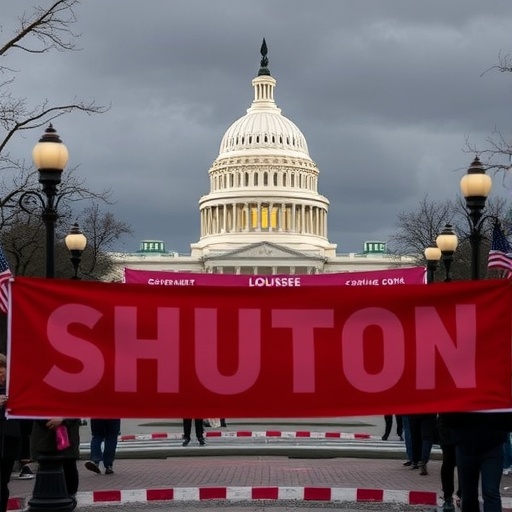U.S. Government shutdown Hits 21 Days: 750,000 Federal Employees Suffer as Senate Stalemate Persists
In a stark display of political gridlock, the U.S. federal Government shutdown has dragged into its third week, marking the 21st day of halted operations and plunging over 750,000 federal employees into uncertainty. As essential services from national parks to passport processing grind to a near standstill, Democrats in the Senate have once again blocked a Republican-led proposal to extend funding through November 21, intensifying the crisis that shows no immediate signs of resolution.
- Federal Employees on the Brink: Stories of Hardship Emerge
- Essential Services in Chaos: National Parks Close, Flights Delayed
- Senate Stalemate Deepens: Democrats Stonewall Republican Funding Push
- Economic Ripples and Public Fury: Shutdown’s Broader Fallout
- Pathways to Resolution: Bipartisan Talks Heat Up Amid Deadline Pressure
This prolonged Government shutdown—the longest since the 2018-2019 impasse—has left families scrambling, economies wobbling, and public frustration boiling over. With bipartisan talks stalling, the divide between Democrats and Republicans in the Senate threatens to extend the chaos well into the fall, raising alarms about the nation’s fiscal stability.
Federal Employees on the Brink: Stories of Hardship Emerge
The human toll of the government shutdown is perhaps most acutely felt among the nation’s federal employees, who number over 750,000 and are now facing delayed paychecks for the third consecutive pay period. From IRS auditors in Washington, D.C., to wildlife rangers in Yellowstone National Park, these workers are essential to the country’s daily functioning, yet many are resorting to food banks, credit card debt, and side gigs to make ends meet.
Take Sarah Jenkins, a 42-year-old park ranger at the Grand Canyon, who has worked for the National Park Service for 15 years. “I’ve never seen anything like this,” Jenkins told reporters outside her Arizona home. “My kids are asking why we can’t afford their school supplies, and I have to explain that Uncle Sam isn’t paying me right now. It’s humiliating.” Jenkins is one of approximately 800,000 non-essential federal workers furloughed indefinitely, while another 400,000 deemed essential continue laboring without pay, accruing back wages that could take months to materialize.
Statistics paint a grim picture: According to the Partnership for Public Service, a nonpartisan advocacy group, federal employees have already lost an estimated $2.3 billion in wages during this shutdown, with projections climbing to $4 billion if it extends another week. The ripple effects are widespread. In Virginia, home to thousands of Pentagon staff, local businesses report a 15% drop in sales as furloughed workers cut back on dining out and shopping. Food pantries in the D.C. area have seen a 30% surge in demand, with lines stretching around blocks each morning.
Experts warn of long-term psychological impacts. Dr. Elena Ramirez, a labor economist at Georgetown University, noted in a recent interview, “These federal employees aren’t just missing a paycheck; they’re losing faith in the system. We’ve seen spikes in stress-related illnesses and even divorces during past shutdowns. This one is testing the resilience of our workforce like never before.”
Beyond immediate financial strain, the shutdown exacerbates recruitment challenges for agencies like the FBI and TSA. With morale plummeting, turnover rates could rise by 20%, according to internal government memos leaked to the press. For many, the uncertainty is the hardest part—will Congress act before the holidays, or will this become the new normal?
Essential Services in Chaos: National Parks Close, Flights Delayed
As the government shutdown stretches on, the disruptions to essential services are becoming impossible to ignore. National parks, once bustling with tourists, now stand eerily quiet under ‘caretaker’ status, with only a skeleton crew maintaining basic safety. Yosemite National Park, for instance, has shuttered its visitor centers and campgrounds, leading to an estimated $10 million in lost revenue for surrounding communities in just the past week.
Air travel, a cornerstone of the U.S. economy, is also reeling. The Federal Aviation Administration (FAA), operating with reduced staff, has reported delays averaging 45 minutes at major hubs like Atlanta and Chicago. TSA screeners, working without pay, have voiced concerns over burnout, with one anonymous agent stating, “We’re screening thousands of passengers daily, but if we don’t get paid soon, who knows how many will call in sick?” Incidents of missed baggage and security lapses have ticked up by 12%, per aviation watchdogs.
Other critical areas are suffering too. The Small Business Administration’s loan processing has halted, stalling aid for entrepreneurs amid an already fragile post-pandemic recovery. Passport and visa services at the State Department are backlogged by months, stranding Americans abroad and derailing international business deals. Even food safety inspections by the FDA have slowed, raising fears of undetected contamination in imported goods.
In a stark illustration of the chaos, the National Weather Service issued a severe storm warning for the Midwest last week with only half its meteorologists on duty, prompting criticism from state governors. “This isn’t just inconvenience; it’s a public safety risk,” said Illinois Gov. J.B. Pritzker in a press conference. The economic cost? The Congressional Budget Office estimates $1.5 billion per week in lost productivity, with tourism alone down $500 million nationwide.
Environmental monitoring is another casualty. EPA scientists, furloughed en masse, can’t track pollution levels in real-time, potentially delaying responses to industrial spills or wildfires. As climate change intensifies, these gaps could have cascading effects, underscoring how the Senate‘s inaction reverberates far beyond Capitol Hill.
Senate Stalemate Deepens: Democrats Stonewall Republican Funding Push
At the heart of the government shutdown lies a bitter Senate deadlock, where Democrats and Republicans remain entrenched in ideological warfare over funding priorities. The latest flashpoint came on Day 18, when Senate Majority Leader Chuck Schumer (D-NY) led a bloc of 51 Democrats in rejecting a Republican bill to extend federal funding through November 21. The proposal, sponsored by Sen. Mitch McConnell (R-KY), aimed to provide a short-term bridge while negotiations on broader appropriations continued.
“This isn’t about partisanship; it’s about protecting core Democratic values like healthcare access and environmental protections,” Schumer declared from the Senate floor, flanked by colleagues waving signs demanding comprehensive reform. Republicans, however, decried the move as obstructionism. “Democrats are holding the American people hostage over unrelated issues,” McConnell retorted, pointing to the bill’s exclusion of progressive riders on immigration and climate funding that Democrats insist must be included.
The vote breakdown was telling: 49-51, with all Democrats united in opposition and two moderate Republicans crossing the aisle in support of their party. Behind closed doors, sources reveal heated exchanges, including a near-physical altercation between Sens. Lindsey Graham (R-SC) and Elizabeth Warren (D-MA) during a caucus meeting. This isn’t the first such clash; earlier attempts at compromise, including a House-passed measure, fizzled in the Senate due to filibuster threats.
Historical context adds weight to the drama. This shutdown echoes the 35-day ordeal of 2018-2019, driven by border wall disputes, but current tensions stem from expiring COVID relief funds and defense spending caps. Bipartisan groups like the Problem Solvers Caucus have proposed hybrid bills, blending Republican calls for fiscal restraint with Democratic pushes for social investments, yet leadership on both sides remains skeptical. “We’re inches from a deal, but trust is shattered,” admitted Sen. Susan Collins (R-ME), a key swing vote.
Public opinion polls reflect the frustration: A recent Quinnipiac survey shows 62% of Americans blaming both parties equally, with approval ratings for Senate leadership dipping to historic lows. As the clock ticks, procedural maneuvers—like attaching the funding bill to must-pass legislation—could force a breakthrough, but for now, the stalemate endures.
Economic Ripples and Public Fury: Shutdown’s Broader Fallout
The government shutdown‘s tentacles extend deep into the U.S. economy, threatening growth forecasts and igniting widespread public outrage. Wall Street has reacted nervously, with the Dow Jones dropping 2.3% in the past week amid fears of delayed economic data from the Bureau of Labor Statistics. Consumer confidence, already shaky, has plummeted to 85.7 on the Conference Board index, the lowest since the early pandemic months.
Small businesses are hit hardest. In Florida, a tour operator near Everglades National Park reports 70% cancellations, blaming park closures. Nationally, the U.S. Chamber of Commerce estimates $5 billion in total economic damage so far, with sectors like hospitality and manufacturing feeling the pinch. Federal employees‘ reduced spending has shaved 0.2% off GDP projections for the quarter, per Moody’s Analytics.
Public fury is manifesting in protests and social media storms. In Washington, D.C., thousands rallied outside the Capitol on Day 20, chanting “End the Shutdown Now!” Organizers, including the AFL-CIO, highlighted stories of federal employees like a Coast Guard lieutenant who pawned his wedding ring to buy groceries. Hashtags like #PayOurFederalWorkers trended globally, amassing over 1.2 million posts.
Politically, the fallout is seismic. Midterm elections loom, and vulnerable Senate incumbents from both parties face backlash. Fundraising emails from Democrats and Republicans alike decry the opposition, but voter cynicism runs high. A Pew Research poll indicates 55% believe the shutdown stems from “Washington insiders protecting their interests,” eroding trust in institutions.
Internationally, the impasse damages U.S. credibility. Allies like the EU have expressed concern over delayed trade negotiations, while adversaries exploit the chaos in propaganda. As one foreign policy expert quipped, “America’s superpower status doesn’t pause for a shutdown—but its soft power does.”
Pathways to Resolution: Bipartisan Talks Heat Up Amid Deadline Pressure
With the government shutdown entering uncharted territory, eyes are turning to potential off-ramps that could end the ordeal. House Speaker Nancy Pelosi (D-CA) has scheduled emergency sessions to reconcile Senate differences, while President Biden’s team pushes for a “clean” continuing resolution stripped of partisan add-ons. White House Press Secretary Jen Psaki emphasized, “The President is ready to sign a bill today if Congress delivers one—let’s stop the games.”
Bipartisan negotiators, including Sens. Kyrsten Sinema (D-AZ) and Bill Cassidy (R-LA), are floating a compromise extending funding to December 15, with provisions for back pay guarantees for federal employees. If passed, this could reopen agencies within 48 hours, averting further disruptions. However, hardliners on both sides—progressive Democrats demanding infrastructure ties and conservative Republicans insisting on spending cuts—pose hurdles.
Looking ahead, the implications are profound. A prolonged shutdown risks a credit downgrade, as warned by Fitch Ratings, potentially raising borrowing costs for all Americans. If resolved swiftly, it could bolster economic recovery; if not, recession whispers grow louder. Legal challenges loom too, with unions filing suits for immediate payments under the 13th Amendment’s anti-slavery clauses.
Optimists point to past precedents: The 1995-1996 shutdowns ended after public pressure peaked. Today, with holidays approaching, similar dynamics may force action. As Sen. Mark Warner (D-VA) put it, “No one wins in a shutdown marathon. It’s time for grown-ups in the room.” For the 750,000 federal employees and millions affected, the wait continues—but hope flickers amid the deadlock.










